| 8.1 Introduction
8.2 The Impact of Wind Shifts
8.3 Tactical principles
8.4 Tactics Up the Beat
8.5 Tactical Weapons
8.6 Rules Upwind
8.7 No More Tactics
8.1 Introduction
Tactics to Win
We work for years to develop competitive boat handling and boat speed skills. Why? So we can enter the tactical game in a position to win. With the foundation of our performance pyramid taken care of, we can pick our head up out of the boat and enter the world of tactics
Upwind tactics involve positioning against individuals or groups of boats to take advantage of strategic conditions (i.e. wind, shifts, and current), or to control tactical situations (crossings and mark roundings). Over the course of a leg or race, tactics become increasingly important. Early in a leg or race, it is best to avoid confrontations and concentrate on a strategy that will put you near the top. At the end of a leg, you battle tactically to round ahead of those in nearby. Toward the later stages of a race, your general position is relatively fixed, and your efforts focus on boats just ahead and just behind.
Tactics are relatively unimportant in mixed fleet races, where you are racing the clock. In one-design or level rated racing tactics predominateas your closest rivals are the boats nearby.
This chapter will cover Upwind Tactics in seven sections. Following this introduction, Section Two will look at the impact of wind shifts. Section Three describes tactical principles used for positioning and control. Section Four explains how tactics change over the course of a windward leg, while section Five looks at the tactical weapons. Section Six covers rules upwind and their tactical application. After all that, Section Seven tells why and how to eliminate tactics from your racing!
8.2 The Impact of Wind Shifts
Our strategy forms the framework for our tactics. We use tactics to fulfill our strategic goals. One key element of strategy is wind shifts, which we discussed in the previous chapter. As we work to take advantage of shifts, we need to know their tactical impact: How should we position ourselves against our rivals in order to take advantage of the shifts, and what impact do the shifts have?
LEP: Climb the Ladder
Sailing upwind is like climbing a ladder. The rungs of the ladder hang perpendicular to the wind, and boats on the same rung are equally far upwind. Each rung is called a line of equal positionan LEP
Strategy in Brief: Be Near the Shift
When the wind shifts the ladder rotates. A boat closer to the new wind gainshe is on a higher rung, and boats further from the shift end up on a lower rung. The closer to the shift you are, the further you are up the ladder and the less distance you have to sail to get to the mark.
How Much do you Gain (or Lose) in a Shift?
The distances are staggering. When the wind shifts 10° the boat closer to the shift gains 25% of the lateral distance separating the boats.* For boats on the same LEP, and separated by 100 yards the gain is 25 yards. For boats separated by a greater distance the gains/losses are greater**.
For example, if two boats are separated by 848 feet the gain/loss would be 212 feet. 848 feet of separation may seem like a lot but consider
How Quickly it Happens
Imagine two boats sailing close hauled at a boat speed of 6 knots and tacking through 90°. They cross tacks, with the port boat ducking. Each boat sails for one minuteyou know, sixty seconds. After one minute of sailing time, they will be 848 feet apart. A 10° shift will put one boat 212 feet ahead. At six knots, that distance represents 21 seconds of sailing time. Separating for 60 seconds creates a 20+ second gain/loss. Your risk/reward is one-third the time you spend splitting tacks with another boat.
When One Boat is Ahead
When one boat is ahead of another, results are similar. Consider gains and losses as a percent of distance behind, from LEP to LEP. We will consider three cases: the boat behind will have leverage equal to the distance behind either toward the shift (boat 1), away from the shift (boat 2) or be straight downwind with no leverage (boat 3). When the wind shifts 10° the boat closer to the shift gains 19%, the boat away from the shift loses 16%, and surprisingly, the boat straight downwind gains slightly about 2%.
When the boats are further separated the gains and losses increase. We use the term leverage to describe this lateral separation. The further apart boats are the more leverage they have, and the more they stand to gain or lose in a shift. A boat which is behind will pull even with the leader in a 10° shift if his leverage is 5.7 times the distance behind (boat 4). In a bigger shift less leverage is needed to catch up, or to fall twice as far behind! .
WOW!
Through all numbers and examples, one point stands out: wind shifts are a big deal. As I said before, the potential gains/losses are staggering.
The Message
Wind shifts are a big deal. We got that message.
Two corollaries follow:
First, if you can predict the next shift, sail to it.
Second, if you don’t know what to expect, then minimize leverage to minimize the impact of shifts. (Have you ever been unable to anticipate the next shift? Me neither, and the check is in the mail.)
We’ll look at these two corollaries from two perspectives: catching up when you are behind, and protecting a lead when you are ahead.
Catching Up
It is particularly interesting to note that a boat directly behind gains a little on every shift and never loses. When you’re unsure of the next shift, minimize leverage by staying near this no risk position. Try to nibble away at the leader with speed while eliminating the risk due to shifts. Then, when you can predict an upcoming shift, go to it.
By minimizing leverage, you deny the leader the chance to stretch the lead, and you stay within striking distance.
Splitting with the leader just for the sake of splitting is a mistake. You are at least as likely to lose as gain. (Maybe more likely to lose; odds are that the leader is going the right way.) Stay close and wait for an opportunity. Split only when the odds are in your favor.
Staying Ahead
You hear this said about champions: He gets ahead, and he is gone. How do they do it?
About other racers you may hear: Don’t worry about him, eventually he’ll go to pieces. Why?
Tactical dogma when in the lead is stay between the competition and the next mark. Cover ‘em and you can’t lose.
When you’re in the lead, it is not enough to simply stay between the competition and the mark. As we have seen, boats behind gain a little with each shift from that position.
Keep the Initiative
Real leaders continue to lead. To keep the lead, you must keep the initiative. Sail fast, hit the shifts, and do the things you did to get the lead. Pay attention to those behind you, yes; but think in terms of stretching the lead and adding a cushion rather than simply going into a defensive shell and sitting on the lead you’ve got. You certainly don’t want to split with the fleet, but you have to do more than look back. The true champions pay attention to the fleet behind them; but they keep working, keep hitting the shifts, keep looking ahead. (I’ve yet to test this myself, but I’m ready to give it a try).
All too often sailors change their tactics once in the lead, and lose the initiative. Maybe you’ve experienced this. You kick and scratch and fight your way to the lead. Once you get there, you start to shake, you feel queasy, and your eyes glaze over. Curtains, and a quick trip back to the cheap seats.
When you’re sailing with a comfortable lead, proper positioning can help protect it. If the next shift or the mark is to the left, then position yourself to protect your left. Use a loose cover (see Fig. 31 below), and don’t let trailing boats get enough leverage to threaten your lead.
8.3 Tactical Principles
There are a number of general tactical principles to keep in mind as you sail upwind. The overall objectiveyour upwind strategyshould remain the priority. Use tactics to help you achieve that goal.
Keep Clear Air & Freedom
Keep control of your own destiny. Avoid situations where other boats can control you. You need to look ahead and position yourself clear of crowds.
Cross When You Can
This is also called consolidating your lead. If you wait, conditions may change, and you may lose your opportunity
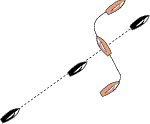
Fig 8 Cross when you can. If you don’t, the wind may shift and you may lose the oppurtunity.
Don’t Let Others Cross You
When the wind shifts, don’t let those who gain consolidate. Go to the next shift and recoup. By staying off to the side, ahead and to leeward, a favorable shift will help you . The catch is that you have to be going the right way. If the shifts are large and difficult to anticipate, you run the risk of being buried if the shift works against you. When things get weird, it may be best to position yourself with the leaders until you can sort things out; then use the Catching Up ideas from the previous section.
Stay Toward the Middle
A championship tactic, which sometimes doesn’t work for the rest of us who spend most of our time in the middle of the fleet. When you are in the lead, or near it, adhere to this rule, as it minimizes leverage for those behind and gives you the ability to go either way to protect your position .
Back where most of the fleet does most of their sailing, the traffic and disturbed air of the middle can be devastating. Yes, sail the middle when you can; but balance this with concerns for clear air and the search for favorable shifts.
When one side of the course is heavily favored, then the middle moves with the fleet. The middle is the middle of the fleet, really. When the entire fleet goes left, the middle goes left with the fleet.
Avoid the Laylines
Once you hit the layline, you are out of options. You are subject to attack, and you are hurt by any shift.
Avoiding the laylines is a good principle, with few exceptions. The most notable exception is in the middle of a huge fleet.
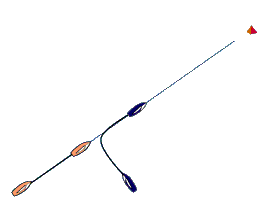
Fig. 11 Once you reach the layline, you run out of options. You are vulnerable to attack, and the shifts no longer help you.
First, you will be forced out of the middle by traffic. Then, as you approach the mark, the turbulence and disturbed air between the laylines must be avoided; often by sailing a few boat lengths beyond the layline to get clear air. Until you have approached the windward mark 52nd in a fleet of 63, you don’t know how bad bad air can be.
Stay With the Fleet
When you are ahead, stay with those behind you. No surprise here. Sail the same breeze as those around you; just sail it better. When you are on the favored side, there is no need to split. Just stay on the favored side of the fleet .
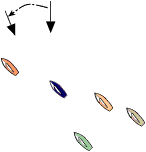
Fig 12. Don’t split with the fleet just because you are behind. Go the right way, or you will lose.
The real application for this principle is sailing to a favored side when you are behind. It is true that you can’t win by following, but tacking away will only make matters worse. Until the leaders make a mistake, you won’t catch ‘em. Hang on even if it hurts, and stay close. Tacking away from the favored side or a persistent shift is not the answer. You’ll get a chance to fight back if you stay close, and you’ll get hammered if you tack away.
Lead the Crowd
As you approach a crowd of boats, tack ahead and to leeward, rather than sail through the crowd to their hip. There are a number of reasons why this works. First, it is best to stay with the fleet, as mentioned above. Second, if the crowd is sailing toward the next shift, then you will be the first to get it. Third, once you sail into a crowd you may have trouble finding clear air or a tacking lane.
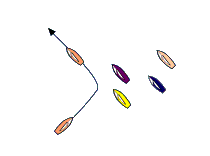
Fig.13 Lead the crowd by tacking ahead and to leaward.
Fourth, if you decide you want to get across to the outside, you can tack again and exercise that option later. Once you cross the crowd, you can’t reconsider and return to the ahead and to leeward position.
This principle is particularly powerful if you can lead the crowd toward the middle of the course. On the other hand, you may want to abandon this principle if crossing the crowd will get you to the inside of the group, closer to the middle. From a position on the inside hip, you are ready to lead the fleet to the middle as they tack that way .
Cover When Ahead
Stay between the fleet and the next shift. If you are ahead and can anticipate the next shift, sail to it. If you are ahead, you have to hit the shifts to stay ahead. Your lead won’t last long if you follow the fleet into the shifts .
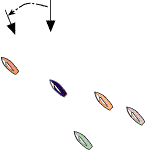
Fig. 14 When in front, cover by staying between the fleet and the next shift.
. If you can’t find the next shift, find the mark and protect your position that way. Lead the fleet toward the mark or shift.
Sometimes you can’t cover. There are times when it simply does not pay to cover. When conditions become dramatically shifty, the impulse is to cover tightly. But in these conditions it can prove impossible to cover an opponent. Concentrate on sailing your own race. Try to keep your cool when things get weird.
One-Legged Beats
When the course is skewed by a major wind shift so you can nearly fetch the windward mark, you are sailing a one-legged beat. Tactically, the best position is ahead and to leeward. If the leg is a port fetch, try to avoid a clearing tack to starboard when you round the leeward mark. On a starboard fetch, try to tack immediately at the mark.
From the ahead and to leeward position, you have greater control and better opportunities in wind shifts. If you are lifted you may fetch; and if you are headed, you will be able to tack and cross those on your hip.
If you sail the short leg first, then you will quickly find yourself in the corner with few options.
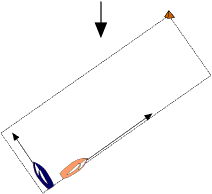
Fig 15. One a one-legged beat sail the long leg first.
More Tactical Ideas
Anticipate
When you’re on port tack, sailing on the hip of another port-tack boat, plan how you will react if he tacks. Will you tack or duck? Your response depends on a number of tactical and strategic factors. Don’t wait for the other boat to tack to decide your response.
Get Blockers To Protect You
You’re on port, and you’re getting ready to tack. You look over your shoulder and see a crowd on your hip.
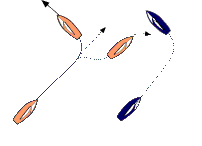
Fig 16 When on the hip of a port tacker, anticaipate his task, Will you tack, cross, or duck?
You need a blocker (a boat ahead and to leeward) to shield you from the crowd .
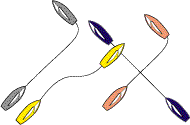
Fig 17. When tacking toward a crowd, get a blcker. Cross him, and tack. Others will have to deal with him first, leaving you free.
A blocker will take all the heat (lee bows etc.) as you sail into the crowd. A boat you can just cross makes an excellent blocker. After you cross, sail two lengths and tack. Now your blocker will lead you through. Anyone who can cross the blocker can cross you. Boats which might normally create a problem for you run into the blocker first. You sail on without interference.
Hidden boat trick!
Watch for this: Two starboard-tack boats are approaching a port-tack boat. The leeward starboard boat waves the port tacker by, ÒGo ahead.Ó Imagine the port tack boat’s surprise when he sees another starboard tacker previously hidden from view!
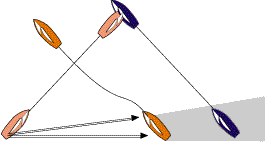
Fig 18. When a starbord boat waves you by. watch out for a second starboard boat previously hidden from view!
8.4 Up the Beat in 3 Stages
Tactics upwind is a matter of positioning for wind shifts and positioning for control. We can divide the beat into three segments. The initial segment is the period after the start or leeward mark rounding when we are sailing in a crowd and fighting for clear air. The middle segment starts when we break out of the crowd and are free to pursue strategy. The final segment is the battle for position approaching the windward mark. Boat-to-boat battles predominate at the beginning and end of the leg, while wind shifts are the focus in the middle segment.
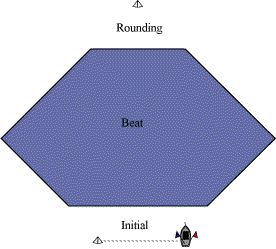
Fig 19. The windward leg can be divided into three tactical segments: the initial segment, the beat, and the rounding.
The Initial Segment: Positioning for Freedom
The priorities during the first part of any beat are to keep clear air and to have the freedom to pursue your strategy. The first few minutes after a start, as discussed earlier, are critical; any advantage gained there will be magnified.
At the beginning of subsequent beats, the goal is to catch the first shift and get to work on strategy. If the goal is to work to the right, it may be necessary to tack shortly after rounding and then tack back when a clear lane to the right is available. If you are outside at the rounding, you may be able to reach through for clear air and save two tacks.

| Fig. 20 A short tack to the left may be needed to find a lane going right. You may be able to foot along the crowd. |
Fig. 21 To go left, tack into an open lane, clear of traffic. |
Fig. 22 During the beat segment, pursue your stratrgy. |
If the strategy is to go left, then you must work to be free to tack after the rounding. Beware the wind shadow and turbulence of boats which have yet to round and are still on the previous leg. While you will have right of way close hauled on starboard, there may still be reason to delay a tack until you can clear that hazard.
The Beat: Strategy Reigns
The middle segment starts once you are clear of the crowds at the start or leeward mark and continues until you start working for position at the windward mark. Tactics on this segment focus on the freedom to pursue your strategy.
The tactical principles discussed above come into play during this segment. The overall objectiveyour upwind strategyshould remain the priority. Use tactics to help you achieve that goal.
The Rounding: Positioning for Control
As you approach the weather mark, work for control of those nearby. Keep clear air, and try to keep from being pinned by others. Inside the laylines, a weather quarter position gives control as a boat on the lee bow is pinned and not free to tack.
This position must be carried all the way to the layline or it will be reversed if both boats tack. On the layline, a lee bow position is preferred, but there is a danger in this position should you fail to fetch the mark.
With marks to port, the left side is inside at the rounding, and a boat on the right controls the last starboard crossing. If you are sailing marks to starboard, then the right owns both the inside position and the last starboard crossing. This puts a premium on controlling the right when marks are to starboard.
The Last Oscillation Is A Persistent Shift
In an oscillating breeze, treat the last shift before the mark as a persistent shift.
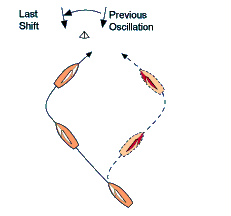
Fig. 23 Sail into the last oscillation going into the mark as though it were a persistant shift.
Sail the header to the layline, then tack for the lift. Any leg which has just one shift should be sailed strategically as you would a persistent shift. Imagine the last part of the leg is just a very short leg with one shift.
Inside the Laylines
A port-starboard crossing near the layline is a common situation which offers many options and counter options.
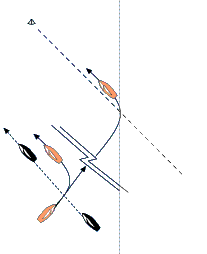
Fig. 24 If a port tacker can cross, he can then tack and pin a starboard boat or sail on to the layline.
If the port-tack boat can cross, he has several choices. He can cross and continue on port tack toward the starboard layline; he can tack to lee bow or cover the starboard tacker, giving the starboard tacker incentive to tack away; or he can tack to pin the starboard tacker and carry out to the port layline.
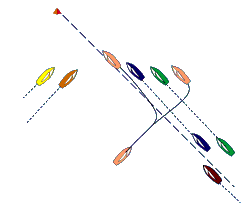
Fig. 26 A port tacker can lee bow a starboard boat on the layline, or cross and use the starboard boat as a blocker.
If the port tacker cannot cross, then he can tack or duck. If he chooses to tack, he may be pinned out until the starboard boat tacks. A well-executed duck creates an opportunity for a reversal at the next crossing. To prevent a reversal, the starboard tack boat can respond with a slam dunk. If the starboard tacker is not prepared or fails to execute properly, then he will not be able to prevent a reversal
If the port-tack boat sails to the starboard tack layline, then the starboard tacker (now coming in on port) may be able to lee bow and lead to the mark. If the port tacker tacks short of the layline, then we have a reversal of our earlier situation. Go back 4 paragraphs. Do not round the mark. Do not collect $200.
On the Laylines
If the starboard tacker is on the layline, a port tacker can tack ahead or on the lee bow to round ahead of the starboard tacker. If there is doubt about whether or not the starboard tacker will fetch, it is best to cross and tack to weather, using the starboard tacker as a blocker against those coming into the layline later.
If there is a crowd on the layline, tack away and come back later rather than sail extra distance or in bad air at the layline. Once you go to the layline and duck the crowd, you concede (for that leg). By tacking out you give yourself one more chanceat the risk of losing others if the layline fills.
Bail Out Early
You’re on the layline. Almost. Just a little shy of the layline maybe, but you can pinch up and make it. Maybe. Stop kidding yourself and bail out now.
If you bail out early, there may still be room on the layline to get back in line. If you wait until later to flop to port, it may be too late. You will end up ducking the entire fleet before you find a space on the layline.
If you are approaching the mark in clear air and no turbulence, you might be able to pinch up and make it; but if there are other boats on your air then bail out early.
8.5 Tactical Weapons
Our upwind strategy gives us the big picture, and our tactical principles guide us as we confront groups of boats. Tactical weapons are the tools we use to put the principles into practice and achieve our strategic goals. Broadly speaking, there are two general categories: Those that allow us to control and influence others, and those which allow us to prevent others from doing the same to us.
As we look at tactical weapons, we will discuss what each does and how it is used.
Controlling other Boats
Tight Cover
A tight cover is a an aggressive move which slows an adversary by putting the him in your wind shadow. A tight cover necessitates a response. Use a tight cover when you want to force another boat away.
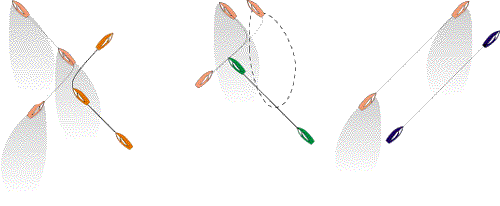
| Fig. 29 A tight cover puts your rival in your wind shadow and forces a response. |
Fig 30. Tack so you end up upwind; don’t tack when you are upwind. |
Fig. 31 A loose cover does not impede the progress of your opponent. It keeps you sailing in the same conditions as your rival. |
Tack so you are directly upwind after accelerating or the rival may escape your shadow.
Loose Cover
A loose cover is a course parallel to the opponent(s) which does not put the other boat(s) in our wind shadow. A loose cover is more defensive than a tight cover. A loose cover does not impede the progress of the other boat(s). It puts you in a position where you can protect your lead.
Your intent with a loose cover is to deny your opponent the opportunity to sail different conditions than you are sailing. A tight cover, on the other hand, often forces your opponent to tack away. The danger with a tight cover is that your opponent then separates from you, and may find more favorable conditions.
When you are unsure of what to expect next with the wind, a loose cover lets you sail near your opponent.
Go Ahead and Cover
If you are ready to tack but delay for a moment, you can dump bad air on an opponent close behind. This frustrates the opponent, as he must now tack away or sail in bad air. Given the chance, you can be sure he will return the favor.
The assumption is that you would be tacking anyhow, for strategic reasons, and take the opportunity to force the rival to sail the wrong way.
The Stupid Cover
You are crossing a close rival and tack on his air. You hadn’t planned to tack, but couldn’t pass up the opportunity to face on your rival. Trouble is, you were going the right way, towards a shift perhaps. Now you have traded places. You are going the wrong way, and you have forced your rival to go where you wanted to go. Stupid.
Don’t lose sight of your strategy as you play tactical games.
Herding
Herding is any technique which encourages other boats to go the same way you are going. Hmm. Why would you want to do that? And how would you do it?
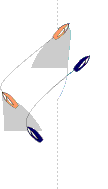
Fig. 33 You can heard a boat with a tight cover on one tack and a loose cover on the other tack.
You herd other boats along when you are fearful of what may happen if they get away. If you are uncertain of what the wind shifts will do, you want to stay near others to minimize your risk.
There are two basic ways to herd another boat. The first uses a series of tight covers on one tack and loose covers on the other tack. This encourages the opponent to sail the loosely covered tack. The second is with a pin, which is described below.
Pin
A pin is a tack into position on another boat’s hip which prevents the opponent from tacking away.
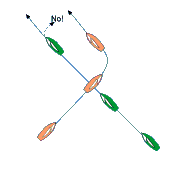
Fig. 34 A pin prevents the outside boat from tacking until the inside boat tacks.
It is used approaching a layline, where you can prevent your opponent from tacking to the mark until you do. It is also useful when herding one boat back toward a pack you want to cover.
Slam Dunk
The Slam Dunk is a technique for pinning a port-tack boat after he ducks a starboard-tack boat. Immediately after the port tacker ducks, the starboard boat tacks.
The Slam Duck does not always work. The Slam Dunk is a good way to pin a rival out to the starboard tack layline if it is not too far away, but over time the leeward boat can often gas off the windward boat.

| Fig. 35 A Slam Dunk is used by a starboard-tack boat to pin a port tacker. It doesn’t always work. |
Fig. 36 Tack into a position on top of another boat to put them in your wind shadow. |
Fig. 37 A tack directly in front of another boat will push the rival back. |
Using Your Wind Shadow
You can slow another boat by positioning your wind shadow on him. Once in your wind shadow, the opponent can either sail slowly or tack away.
From Directly Upwind
The simplest way to attack another boat is to position yourself directly upwind. This is the epitome of a tight cover. When tacking into this position, remember that you want to be directly upwind after you finish your tack and regain speed. It is common for attacking boats to tack too late and let the target boat break through.
From Ahead
Another effective position for attack is directly in line with the opponent. The turbulence off your sails will foul the air for a several boat lengths off your stern. To assure that your opponent cannot escape your wind shadow without tacking, aim for a position between directly upwind and ahead.
From the Lee Bow
As the name suggests, a lee bow position is on the leeward bow of an opponent. Boats create a surprising amount of turbulence to windward. Tacking ahead and to leeward can have a devastating effect.
When you tack on a lee bow, be sure you have proper position. You must be nearly a full boat length ahead in order to lee bow properly; otherwise the opponent will squeeze up and put you in a pin; or worse, he may even roll you and force you to tack again.
Defending Yourself
The defence from attack is anticipation and quick response. In order to survive an attack, you must break through to clear air before the attacker has reached full speed. Once the attacker is up to speed, it is nearly impossible to break clear.
Squeeze Up to Windward
If an opponent tacks on your lee bow, you may be able to escape by pinching up into clear air. React as soon as you are attacked. Once you fall into the attacker’s exhaust, performance will suffer and you will not be able escape.
If the attacker’s position is strong, tack out as soon as possible, before the attack impacts your ability to tack and escape smoothly.
Drive Through to Leeward
If a boat tacks on your air, you can either tack away immediately or try to drive through to leeward to clear air. If you anticipate the attack, you can prepare to respond. If you want to stay on your present tack, then reach off slightly as soon as the attacker crosses your bow. With a little extra speed and a slightly late tack by the opponent, you may be able to break through in front of his wind shadow.
If you plan to tack away, then do so immediately. Start your clearing tack while you still have full speed to minimize the hurt.
Don’t Tack into a Pin
When tacking to leeward of a boat or boats, do so with enough room to be free to tack back should the need arise. Don’t hand a rival boat the power to decide when you will next be free to tack.
Sucker Cover
If you are preparing to tack and see a rival coming, you may want to delay your tack for two reasons. One is to avoid tacking into a pin. The other is to tempt the rival to tack on you (and presumably sail off in the wrong direction) while you tack as planned (presumably going the right way). See earlier Figure 32 for stupid cover, but now you are the other guy!
Wave ‘em By
A port tacker who may or may not cross you can become a real nuisance if he throws in a last second lee bow tack. If you want to continue on starboard, wave ‘em by, even if you have to duck a little bit. Anything to encourage him to keep going the wrong way and stay out of your way.

| Fig. 41 If you are going the right way, wave a port tacker by, even if you have a to duck a little. |
Fig. 42 When in doubt duck. |
Fig. 43 Make a smooth turn and carry speed as you trim up. |
Ducking and Reversal
You’re on port tack, and you are approaching a starboard-tack boat. You have five options: Cross, lee bow, cross and tack, tack, or duck. Your selection depends on whether or not you can cross, and which way you want to go. If you can cross, go ahead. Or lee bow, as detailed in Figure 39. If you can cross, and you are unsure which way to go, then cross and tack to put your opponent in a loose cover. If you can’t cross, then tack or duckÐwhat would you do in the absence of the other boat? If you decide to tack, try not to tack into a pin. Otherwise, duck.
Take a Bearing
You can tell if you will cross by taking a bearing from your stern to the starboard boat’s bow. If the bearing is increasing, you will cross.
If there is doubt about crossing, then duck. Don’t forfeit the race with a protest. And don’t wait for the last instant to decide. A good smooth duck costs little. A poor duck or a crash tack can be a disaster.
Here’s How it Works: As you approach it looks close. ÒLet’s duck.Ó Wave to the starboard tack boat so they know you see them. No need to yell. From a few lengths, ease your main and jib slightly and bear off. Aim for the spot where the starboard boat will be as you pass. A boat length away, your bow will be pointed at his. He’ll sail a boat length, and you’ll pass smartly under his stern. Well, maybe don’t aim exactly at his bow, but you get my drift.
As you pass under his stern you want to be going faster than your close-hauled speed (after reaching off), but you want to be trimmed up to close hauled again. You must ease to build speed when you bear off, but don’t wait until you have passed to trim up again. Repeat: faster than close-hauled and trimmed all the way as you pass under his stern. You get a lift from the air off his sails. Pinch up in it and work to weather. If you’re lucky, you’ll even be able to surf out on his stern wave.
You sail fast, and eventually you tack. Your opponent tacks too. You come together; only this time you’re on starboard. You give him a wave. Theoretically he will cross you by the margin of your duck. Too close to call. Not only that, but you were going faster than full speed as you passed under his stern. You made up some of the distance. He can’t cross. He’ll duck no, tack . he can’t decide.
Here’s how it doesn’t work #1: He may cross. No, he can’t. He decides to duck, no, tack. He throws the helm down. The crew are caught by surprise. The jib backs before it is finally released. It luffs on the new tack. No one was ready. There was no warning. Finally the jib is trimmed. As the sails fill the old foe is safely behind, in your wind shadow, unnerved, confused, and sailing badly.
Or #2: He may cross. No, he can’t. He decides to duck, no, tack. Yes, duck. He pulls the helm up under his chin, but the boat hardly responds. The jib sheet is thrown off. ÒI thought you said tack.Ó After a nervous moment the rudder grabs and the boat pivots down to a broad reach, sailing nearly parallel to you. Passing under your stern on a reciprocal course, they head the wrong way, finally coming to course about 2 boat lengths to leeward. The jib comes in slowly.
Or #3: He may cross. No, he can’t. He decides to duck, no, tack. Yes, duck. He pulls the helm up under his chin, but the boat hardly responds. The main has not been eased and the boat won’t bear off. He hits you amidships, just behind the shrouds, and takes a big chunk out of your port rail. The only thing bigger than the hole in their bow are their eyes.
In order to achieve a reversal, you must duck properly. Look ahead, and be ready to react.
8.6 Rules Upwind
The main rules upwind are On Opposite Tacks (Rule 10), Same Tack, Overlapped (Rule 11), and While Tacking (Rule 13). The Mark and Obstruction rules (Section C) also come into play upwind. We generally refer to these as Starboard/Port, Windward/Leeward, Tacking too Close, and Bouy Room.
It is a miracle to survive a protest. If you scare someone and raise their blood pressure when tacking or crossing, they may protest you and throw you out. The same applies if you get someone angry. Never mind the fine print, that is how the rules work.
There are two common ways to get in trouble, greed and surprise, both of which can cloud good judgment. Don’t be greedy, and look ahead to avoid surprises.
Starboard/Port (Rule 10)
The next time you are on port tack in a close crossing consider this: Racing sailors would rather have their house burn down than crash their boat. After all, the family can always sleep on the boat; but if they crash their boat, they can’t race the house. The guy on starboard is not going to risk crashing his boat to prove that you could cross. If it is close, he will bear off, and protest. Don’t risk it. Duck instead .
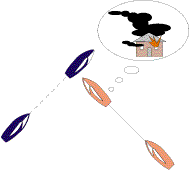
Fig. 46 When on port, don’t expect a starboard tacker to risk crashing his boat!
As Rule 10 is currently written, the starboard-tack boat is no longer frozen by the approach of a port tacker. A starboard-tack boat may alter course as long as port has room to keep clear (Rule 16). For example, it would now be legal for starboard to pinch up to prevent port from crossing as long as port still had the option to tack. The freedom of the starboard boat to hunt the port tacker strengthens the starboard boat’s ability to protect the right side of the course. In a close crossing the only sure way for the port-tack boat to go right is to duck.
Windward/Leeward (Rule 11)
Windward boats must stay clear. With everyone sailing close hauled, the windward/leeward rules are not as volatile upwind as they are downwind; but windward boats must still be careful. Even if your boat is not as close winded (doesn’t point as high) as a leeward boat, you must stay clear.
Tacking Too Close (Rule 13)
The tacking boat must complete her tack (finish turning and be on course) before the right-of-way boat initiates an evasive maneuver, or she has tacked too close. If it comes to a protest, then not only must you tack legally, you must also be able to prove it. Be careful.
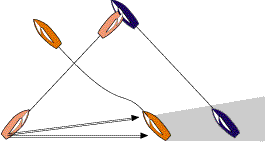
Fig. 48 You have tacked too close if the trailing boat must start evasive maeuvers before you finish your turn.
Obstructions (Rules 18 and 19)
When two (or more) port tack boats approach a starboard-tack boat, the port tackers must stay clear. The starboard-tack boat ranks as an obstruction. The port-tack boats may duck or tack in order to stay clear. The leeward port tacker may choose to duck and give others room to duck as well, or he may choose to tack.
If the leeward boat chooses to tack, he must hail the boat(s) to windward (Rule 19). The windward boat must tack, or hail ÒYou tack,Ó and stay clear. The leeward boat must tack as soon as he gets a response (either action or words).
Windward Mark Roundings
The mark rounding rules at the windward mark differ from those on a free leg of the course. There are three basic situations:
1) Both boats on starboard tack, leaving the mark to port, (or both on port, mark to starboard).
This is a windward/leeward or clear ahead/clear astern situation. The boat to leeward or ahead has right of way, and may luff to round the mark (this is proper course). The other boat must keep clear.
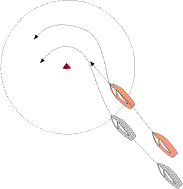
Fig. 50 The inside, leeward boat has right of way.
A boat clear ahead which must tack to round the mark must obey Rule 13: While Tacking.
2) One boat on starboard, one on port. Starboard/Port and Tacking-too-close rules apply. There is no buoy room for boats on opposite tacks at the windward mark (Rule 18.1 b). At a port rounding, the port tacker must stay clear.
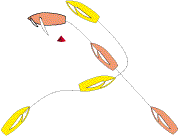
Fig 51 The starboard boat has the right of way. There is no buoy room.
If a port-tack boat tacks to starboard inside the two boat length circle, then Rule 18.3 applies. If the starboard boat must head up to avoid the tacking boat, the tacking boat has violated the rule. Furthermore, if the starboard boat overlaps the tacking boat to the inside, the tacking boat must keep clear.
The burdens on the boat tacking inside the two boat length circle are so onerous that a tack outside the circle is advised.
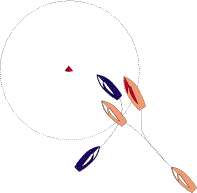
Fig. 52 A boat tacking inside the two boat length circle has no rights.
3) Two boats on port tack. When two port tackers approach a mark to be left to port, (or two starboard tackers for a starboard rounding), the buoy room rules apply. The outside boat must give the inside boat room to round and tack if the two are overlapped when the outside boat reaches the two boat length circle (Fig. 53).
Marks To Starboard
The mark rounding rules are the same when marks are to starboard, but they do not work as cleanly. At a starboard rounding, the starboard tacker has right of way while on course, but is not entitled to tack in a port tacker’s path. The port tacker must stall, duck, or tack away while the starboard tack boat crosses ahead. The situation gets unruly during a crowded starboard rounding.
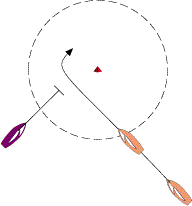
Fig. 54 With marks to starbard, the port boat must stall while starboard crosses, Starboard must not tack too close.
Hitting The Mark (Rule 31)
A boat which hits a mark must immediately get clear of other boats and do a 360° before proceeding. While doing a penalty turn, a boat has no rights and must stay clear of all other boats. If the boat was wrongfully pushed into the mark, she may proceed, but she must protest the offending boat.
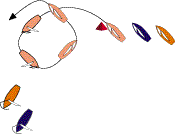
Fig. 55 A boat which hits the mark must do a 360.
Rules, Ethics, and Self Interest
The rules upwind are straightforward, much more so than at starts or offwind marks. Protests are usually the result of greed or surprise which cloud your judgment. Don’t get greedybe ready to duck if you can’t cross cleanly, and look ahead to avoid surprise.
When you have the right of way, you need not protest every offense. You can protest a close port/starboard; but you can also hail the offender, ÒYou owe me one.Ó In the long run, your own interests will be better served if you don’t protest unless your performance suffers. If you protest even when the port boat might have made it, you will probably win the protest. He will be thrown out, and he will doubtless look for a chance to return the favor.
At the same time, you have an obligation to protest a gross offense. If you would cut a port tack boat in two, you owe it to the rest of the fleet to protest the port boat. Otherwise you are condoning cheating. Ideally the port boat will withdraw or take a penalty without forcing you to file.
8.7 No More Tactics!
Tactics provide the thrill of direct confrontation with our rivals. The interaction of attack and response challenges our skills to react as situations evolve. We must consider not only the boats at hand, but also the rest of the fleet and our overall race strategy as we make split second decisions. This is hard!
Not only that, but if the wind is shifty we can lose hundreds of yards in a matter is minutes. This is scary.
Maybe we’d be better off eliminating tactics from our racing, or at least minimizing their impact, but how?
No More Tactics
The trick is to rely on things you can control: boat handling and boat speed. Then you can minimize the impact of things you can’t control: the wind and other boats. Do this by staying near the fleet, while positioning yourself to take advantage of known shifts. The more you can rely on things you can control, the less you will have to rely on things you can’t. |


















